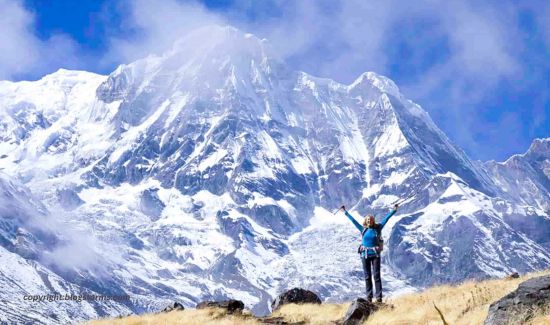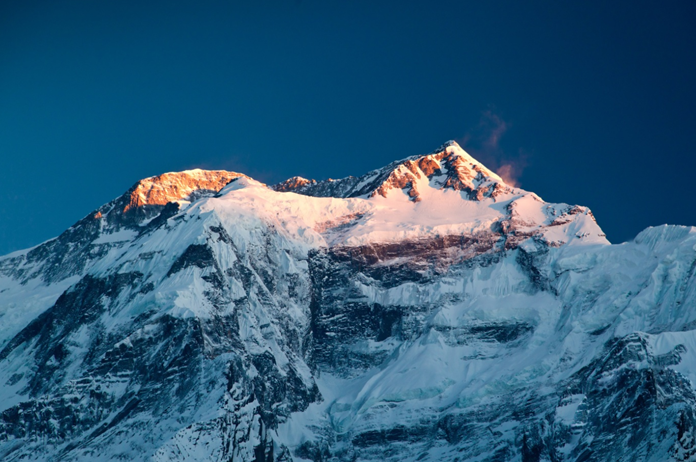Annapurna Base Camp trek is the perfect paradise path for adventure lovers presenting them the views of the Himalayas, the beautiful natural flora and fauna, and the rich cultural heritage of the region.
From the above words, you may think that ABC trek is all about joyful experiences but there is a lot to describe about Annapurna base camp hike difficulty. Trek is difficult because you have to go through high mountain passes and dense forests along with dealing with altitude sickness.
Moreover, the Annapurna Base Camp trek difficulty level increases more due to the unpredictable weather. That’s why you have to be prepared to deal with these challenging factors.
To learn more about the Annapurna base Camp trek difficulty, factors that makes the hike difficult, and some tips to make the trek a bit easier then, continue reading the blogbelow.
Terrain and Altitude
A. Diverse terrain encountered along the trekking route
When going hiking, it is obvious that you will pass through diverse landscapes and hills. The ABC trekking path is also surrounded by diverse landscapes with rocky hills. This feature makes the region more beautiful and adventurous.
You will begin your trek in NayaPul and pass through villages like Ghandruk, Chhomrong, Himalaya, and Machhapuchhre Base Camp before reaching the Annapurna Base Camp.
The actual path trek is much more difficult than just sitting on the couch In front of the people and describing them. Because the path includes slope lands, uphill and downhill, rocky paths, and narrow sections.
As you go through lush forests, you will get an opportunity to watch the birds, and the wild animals. It provides you with unique ecological experiences.
B. Altitude sickness, its potential impact and acclimatization
As you go to higher altitudes, it is sure that you may face altitude-related problems. The lack of oxygen level at higher levels of landscapes may cause health problems like headaches, nausea, fatigue, dizziness, and so on.
These problems are normal when treated at an early stage. Otherwise, these health problems can lead to serious and life-threatening issues. So, you have to take the necessary steps to prevent the altitude sickness.
At this point, the acclimatization process comes as a life savior. The process includes ascending downwards, staying hydrated, and staying positive can help you go through altitude-related problems.
C. Proper preparation for high altitude trekking
To be able to face altitude level problems, you have to do physical training, mental preparation, and light backpacking including all necessary gear.
During the trek, you will go through high hills and low hills. These ups and downs require physical strength and cardiovascular fitness.
By doing cardio like jogging and running, and strength training like squats, push-ups, and deadlifts, you can build your cardiovascular endurance and physical strength.
In contrast, mental preparations are also equally important for the trek. You have to maintain a positive attitude during the trek to prevent anxiety and panic attacks while facing challenges.
Before going on the hike, check all the items and gear and try to pack lightly. Also, hiring guides and porters make your journey a little easier.
Weather Conditions in annapurna
A. Unpredictable weather patterns and challenges posed by it
Due to the diverse and unpredictable weather patterns, you may face moderate difficulty levels in the Annapurna Base Camp trek. The spring and autumn season gives you less relief than the winter season because the weather is stable at these seasons.

But, if you are planning to go in the winter season, then prepare yourself to face the cold conditions and snowfall problems at higher elevations. The temperature can drop up to -17°C in January and brings extreme cold, heavy snowfall, and freezing temperatures.
Moreover, the summer season brings rainfall and leeches. You may face problems while trekking in monsoon time in the summer season due to slippery paths, and unstable weather conditions.
B. Packing appropriate clothing and gear
You have to pack appropriate clothing and gear, to tackle various weather conditions. For spring and autumn, pack lightweight clothes like shirts, pants, thermals, trekking shoes, wind cheater jackets, sun hats, sunglasses, and so on.
Moreover, in summer, you can include all the above-mentioned items along with rain jackets, a rain pant, waterproof trekking boots, and waterproof gear. And, to stay warm in winter, pack warm shirts, a woolen scarf, a wooden scarf, layered clothing, a down jacket, gloves, thermals, and other items that are lightweight.
C. Physical Demands
Physical demands are high when going through moderate trekking areas like the Annapurna base camp trekking area. You have to do both uphill and downhill sections during the hike.
Compared to downhill sections, you will find uphill a little challenging and difficult. This is because of vertical slopes and rocky landscapes. In contrast, downhill is also a little tough due to walking over stone stairs.
Accommodation and Facilities
A. The basic tea houses and lodges along the trekking route
The basic tea house and lodges are the perfect accommodation for those who want the basic facilities with varying facilities. In short, you can get basic rooms with twin beds, shared bathrooms, and communal dining areas.
Basic local and international dishes like Dal bhaat and momos are served in these tea houses. In contrast, luxury lodges provides you more comfort with private rooms, attached bathrooms, and facilities like hot showers, electricity, and wi-fialso.
B. Limited facilities available in remote areas
There may be limited facilities available in the remote areas of Annapurna region. You may have to shower with slightly warm water due to frozen pipes. Moreover, you may face internet problem as there is less availability of WiFi in remote areas.
Navigation and Trail Difficulty
A. Challenging trail conditions, including narrow paths and steep ascents
The Annapurna Base Camp trek’s difficulty goes to the next level due to its challenging trail conditions. You have to go through narrow paths and slope landscapes.
Moreover, you have to face altitude sickness when going through the difficult trails along the altitude gain. This makes the paths more challenging.
There is also some effect of weather conditions on path difficulty. The unpredictable changes from sunny and warm to cold and rainy or snowy make the path muddy or snowy. You may slip or may face difficulty in walking on these trails.
Sometimes you may encounter communication challenges, making it difficult to get up-to-date information about the conditions. These conditions can be more disturbing as there will be a lack of reliable communication infrastructure leading to anxiety-related problems.
B. Potential navigation challenges, especially in adverse weather conditions
Potential navigation challenges due to adverse weather conditions can affect your journey. As discussed earlier, you have to go through diverse landscapes from subtropical forests to alpine landscapes and snowy paths. These paths are full of unique obstacles.
Going through these types of path, especially in adverse weather conditions can impact visibility, and finding the right paths can be more difficult.
Fog covers all the paths with light smoke. So you should wear comfortable, waterproof and strong boots with waterproof clothing. Even if you slip in the path, there will be minimal injuries. These clothing and gears help you handle challenging weather conditions.
Furthermore, you can use maps, compasses, or GPS devices to find the right paths. These gears will not face internet problems or connection issues. Because GPS works in satellite connection and compasses don’t need network connection.
C. Importance of hiring a knowledgeable guide
Hiring a guide can be worth spending during your trekking journey. A knowledgeable guide can help you go through difficult paths, and overcome various challenges along the way.
You can plan the route in a better way with the help and guidance from expert guides. They also make sure that you visit every possible place, and assist you in arranging food, accommodation, and other essentials.
Read Also: Blogstorms
Some important tips
- Be physically prepared by doing cardiovascular exercises, strength training, and flexibility exercises- By doing these exercises, you will be able to face the challenges without hurting yourself or minimal damage.
- Stay positive, practice meditation, and do yoga before going trekking- Many difficulties are just created by our imaginations and overthinking. Sometimes, you can face challenges by just maintaining a positive mindset and listening to your guide.
- Pack your bag wisely- Pack lightweight clothes which is easy to wash and also include all the necessary gear and supplies. This will make your journey easier.
- Obtain necessary permits and arrange transportation and accommodations- This will help you travel freely without being stopped at the entry point of the destination.
- Stay hydrated, maintain a healthy diet, and take enough rest- By doing these works, you will prevent unwanted health issues. Also, carry some dried fruits like nuts to maintain your energy level throughout the trek.
- Communicate with your fellow trekkers and guides effectively. Also don’t hesitate to ask for help when needed.
- Learn basic first aid and emergency procedures
- Hire a guide or porter who will help you during the trek.
